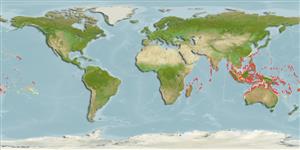Teleostei (teleosts) >
Holocentriformes (Squirrelfishes, soldierfishes) >
Holocentridae (Squirrelfishes, soldierfishes) > Myripristinae
Etymology: Myripristis: Greek, myros, -ou = male of morey eel + Greek, pristis = saw (Ref. 45335).
More on author: Bleeker.
Environment: milieu / climate zone / depth range / distribution range
Ecology
Marine; reef-associated; depth range 0 - 30 m (Ref. 128797). Tropical; 30°N - 30°S, 31°E - 134°W
Indo-Pacific: East Africa to Tuamoto Islands, north to the Ryukyu Islands, south to New Caledonia and the Austral Islands; throughout Micronesia.
Size / Weight / Age
Maturity: Lm ? range ? - ? cm
Max length : 35.0 cm TL male/unsexed; (Ref. 48635); common length : 18.0 cm TL male/unsexed; (Ref. 30573)
Occurs in lagoons, channels, and semi-protected seaward reefs rich in corals. Relatively common near arborescent Acropora or layered Porites rus corals. Feeds on plankton such as crab larvae. Marketed fresh (Ref. 3418).
Life cycle and mating behavior
Maturity | Reproduction | Spawning | Eggs | Fecundity | Larvae
Randall, J.E. and D.W. Greenfield, 1996. Revision of the Indo-Pacific holocentrid fishes of the genus Myripristis, with descriptions of three new species. Indo-Pac. Fish. (25):61 p. (Ref. 12419)
IUCN Red List Status (Ref. 130435: Version 2024-1)
Threat to humans
Harmless
Human uses
Fisheries: minor commercial
Tools
Special reports
Download XML
Internet sources
Estimates based on models
Preferred temperature (Ref.
123201): 25.1 - 29.3, mean 28.4 °C (based on 2644 cells).
Phylogenetic diversity index (Ref.
82804): PD
50 = 0.5000 [Uniqueness, from 0.5 = low to 2.0 = high].
Bayesian length-weight: a=0.02455 (0.01501 - 0.04015), b=3.02 (2.88 - 3.16), in cm total length, based on LWR estimates for this species & Genus-body shape (Ref.
93245).
Trophic level (Ref.
69278): 3.5 ±0.53 se; based on food items.
Resilience (Ref.
120179): High, minimum population doubling time less than 15 months (Preliminary K or Fecundity.).
Fishing Vulnerability (Ref.
59153): Low vulnerability (25 of 100).
Nutrients (Ref.
124155): Calcium = 52.3 [24.5, 156.7] mg/100g; Iron = 0.629 [0.260, 1.267] mg/100g; Protein = 18.7 [17.5, 19.8] %; Omega3 = 0.147 [0.062, 0.337] g/100g; Selenium = 31.8 [19.5, 56.7] μg/100g; VitaminA = 68.1 [27.2, 172.1] μg/100g; Zinc = 1.22 [0.80, 1.85] mg/100g (wet weight);
